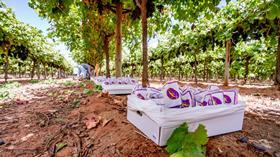
A number of Australian fresh produce peak industry bodies have received funding as part of a Victorian government programme designed to improve the wayagricultural producers get their products to market.
The first tranche of the Food to Marketprogramme distributed A$8.4m (US$6.1m) worth of grants to 13 key industry and regional peak bodies. Global Victoria has contributed an additional A$2.8m (US$2m) to provide export recovery support to industries impacted by disruptions as a result of the pandemic.
Ausveg received A$960,000 (US$704,000) to commence apilotin partnership with the Victorian government to investigate and trial alternative packaging and transport options.
This will help provide viable export pathways remain open for broccoli, cauliflower, asparagus, celery and lettuce crop producers in Victoria.
Cherry Growers Australia received A$750,000 (US$550,000) to support the development of a ‘chemical use for export toolkit’. The toolkit will help industry provide evidence-based, practical advice to businesses planning to export their produce so they can meet the expectations of international markets.
Citrus Australia and the Australian Table Grape Association (ATGA) received A$1.4m (US1m) to lead two innovative traceability pilots for premium fruit – in order to grow, diversify and protect high-value exports.
The pilots include using leading technology, isotope testing, cool-chain tracking and orchard mapping to enhance traceability. This will aim to safeguard the industry from fraudulent products and ensure that the integrity of premium fruit brands and varieties is protected.
Table grape traceability
The ATGA has partnered with Agriculture Victoria for its A$650,000 (US$475,000) pilot project, which commenced in June 2021 and will run for theduration of the 2021/22 table grape harvest season.
ATGA chief executive Jeff Scott said traceability was pivotal to reinforcing competitiveness in international markets and the project would build, diversify and protect exports by developing producer-to-consumer traceability.
“It is important that all growers embrace traceability of their product to ensure the link from the grower to the consumer gives confidence all the way through the supply chain of a high quality product and food safety,” Scott said.
Technology provider Result Group will apply unique serialised GS1 Digital Link-enabled QR code labels to export table grapes, allowing the automated collection of data from farm and supply chain, which can be shared with consumers to authenticate the food’s precise origin and engage with the brand through an open platform smartphone scan.
The Active Digital Identity embedded in the QR code labels ensures each one is unique and traceable – an important innovation in combatting all manner of food fraud.
Labels will also carry critical international traceability data, based on GS1 current standards, covering consumer pack units, cases and pallet codes, as well as time and temperature logging.
Result Group general manager Michael Dossor said they were “beyond excited and proud” to be the traceability technology provider for the programme.
“We have assembled the world’s best technology and, with local talent, adapted it to make it right for the Australian produce sector,” Dossor said.
“Consumers the world over are seeking transparency, while brands are seeking visibility into the journey of individual products from farm through supply chains to consumption.”
GS1 traceability standards will be incorporated into the pilot, enhancing the international compatibility of these supply chains for global exports.
GS1 Australia chief customer officer Marcel Sieira said GS1 was pleased to support traceability projects through advice on GS1 standards and labelling options.
“GS1 standards enable organisations to identify, capture and share information smoothly, creating a common language that underpins systems and processes all over the world,” Sieira said.



